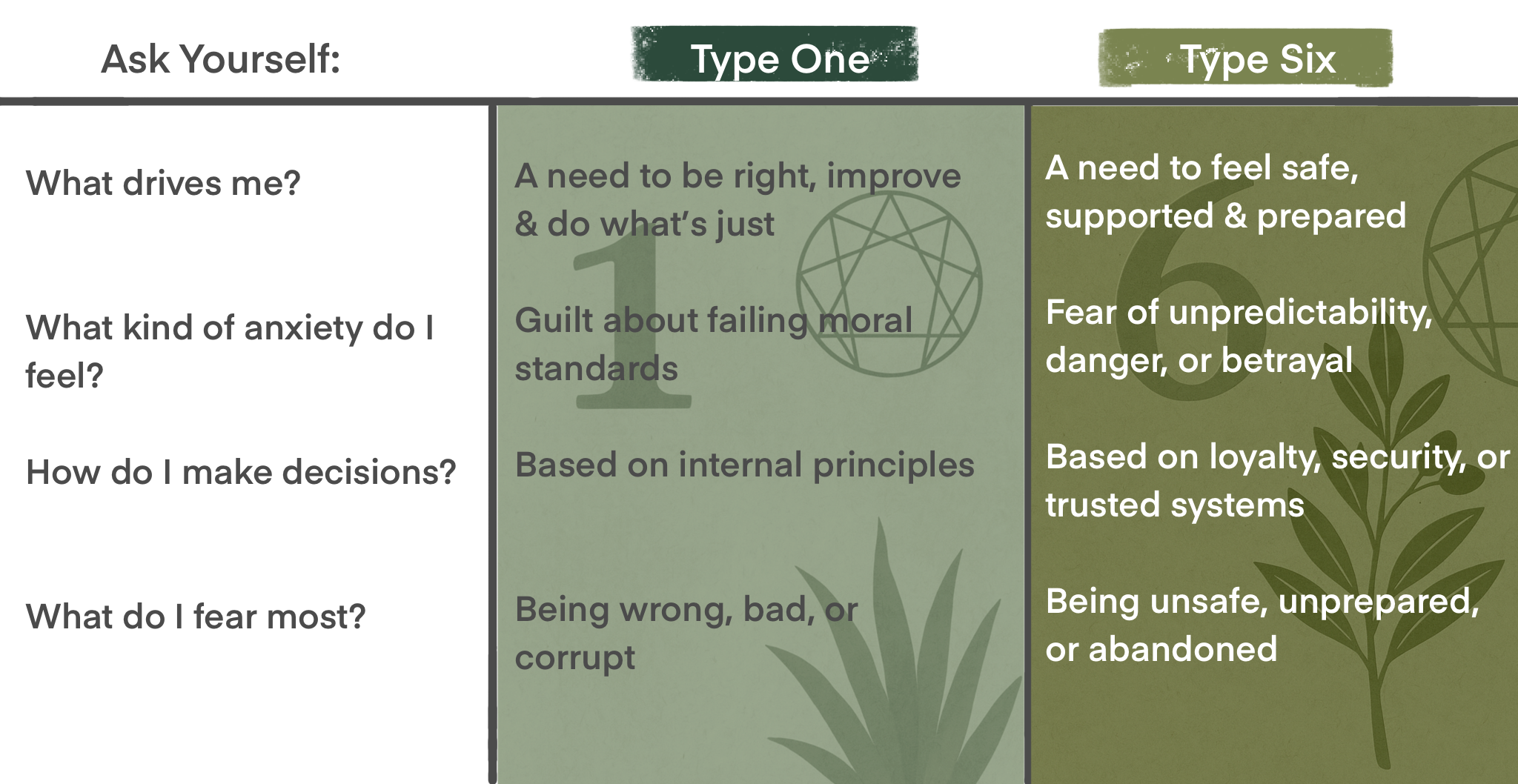In-Depth Comparison
Ones and Sixes can look alike on the surface: responsible, hardworking, rule-following, and often anxious when things feel out of control. They’re both highly principled and tuned in to potential problems, which makes them easy to confuse. But they’re scanning for very different things.
Type One is primarily guided by moral clarity, a strong internal compass that tells them what’s right, what’s wrong, and what needs fixing. When they feel anxious, it’s usually tied to a fear of being bad or doing something incorrectly. Their self-control is rooted in guilt, and their structure comes from a need to live with integrity.
Type Six, by contrast, is scanning for external threats. Their radar is focused on what could go wrong and who they can trust to help them through it. Their anxiety often centers around uncertainty, betrayal, or instability, not moral failure, but danger (real or imagined). Sixes seek support systems, while Ones rely on their own inner structure.
Ones plan for control. Sixes plan to feel safe.
Ones are more linear in their thinking and actions. Sixes often loop in doubt, checking and re-checking whether something is safe or supported.
Sixes tend to test loyalty; Ones tend to test standards.
In stress, Ones often get critical, either toward themselves or others, because something feels out of alignment. Sixes become more reactive or suspicious, spinning out in worst-case-scenario thinking.
If you’re stuck between these two types, ask yourself:
Do I feel more unsettled when things are morally off (One), or when things feel unpredictable or unsupported (Six)?
Is my inner voice focused on being good, or being safe?
Quick Spot-the-Difference Table
Special Considerations & Deeper Theory
Different Intelligence Centers
Type 1 is in the Gut/Instinct Center, grounded in physical tension, control, and a desire to be good and do right.
Type 6 is in the Head Center, guided by anxiety, planning, and a need for certainty or safety.
Even though both may seem cautious, principled, or rule-following, the emotional engine under the hood is different:
Ones act from an internalized sense of “should.”
Sixes act from a desire for security, trust, and reassurance.
Shared Traits: Responsibility & Vigilance
Both types can seem hyper-responsible, rule-aware, and future-focused.
Ones feel responsible for maintaining integrity or correcting what’s wrong.
Sixes feel responsible for anticipating danger or earning safety through loyalty.
This can lead to behavioral overlap, especially in Sixes with strong internal authorities or Ones who over-rely on outer structures to feel “right.”
Wing Influence: 1w9 and 6w5
A 1w9 may come across as cautious, composed, and quietly principled, mistaken for a more withdrawn or analytical Six.
A 6w5 can present as stoic, rule-bound, and skeptical of emotion, traits that might resemble a controlled or critical One.
Relational Stance: Shared External Referencing, Different Focus
Both types are external processors and reference something outside themselves when deciding how to act:
Ones (Dependent Stance) reference moral rules or internalized “shoulds” to guide behavior.
Sixes (also in the Dependent Stance) reference trusted people or systems for safety and guidance.
Here’s the nuance:
A One may challenge or reform the rules once internalized.
A Six may obey the rules for security, but also question or rebel against authority figures if trust is shaky.
Stress & Growth Paths Add Complexity
Ones go to Seven in growth, becoming more spontaneous, curious, and lighthearted, sometimes looking like a relaxed, loyal Six in a trusting relationship.
Sixes go to Three in stress, becoming more image-conscious and productivity-driven, which can resemble a striving, reforming One.
This motion can muddy type identification, especially in high-functioning Sixes or perfectionist Ones.
Common Mistyping Pitfalls
You might think you're a Six if you're a One who second-guesses your decisions or fixates on what could go wrong.
You might think you're a One if you're a Six who adheres tightly to rules, systems, or moral codes to create safety and earn approval.
Both may struggle with internal critics. One’s is shame-based and rigid, while Six’s is anxious and recursive.
Reflect & Explore
Are you more tuned into what’s right (One), or what’s secure (Six)?
Do you lean on inner principles (One), or seek reassurance from others (Six)?
When you anticipate problems, is it because something’s not ethical (One)... or something might go wrong (Six)?

